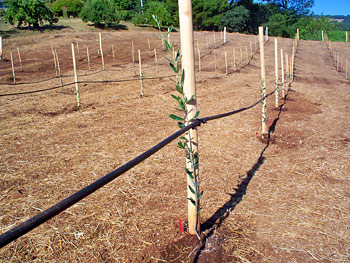Olive Tree Characteristics
 Growth Habits
Growth Habits
The olive is an evergreen tree growing to 50 ft. in height with a spread of about 30 ft. The tree can be kept to about 20 ft. with regular pruning. The graceful, billowing appearance of the olive tree is very attractive. In an all-green garden its grayish foliage serves as an interesting accent while the gnarled branching pattern is also highly distinctive. Olive trees are long-lived with a life expectancy of 500 years. The trees are also tenacious and resilient, easily sprouting back even when chopped to the ground.
Foliage
The olive’s feather-shaped leaves grow opposite one another. The leaf skin is rich in tannin, which gives the mature leaf its gray-green appearance. The leaves drop and are replaced every two or three years, leaf-fall usually occurring at the same time new growth appears in the spring.
Flowers
The small, fragrant, cream-colored olive flowers are largely hidden by the evergreen leaves and grow on a long stem arising from the leaf axils. The olive tree produces two kinds of flowers: a perfect flower containing both male and female parts, and a staminate flower with stamens only. The flowers are largely wind pollinated with most olive varieties being self-pollinating, although fruit set is usually improved by cross pollination with other varieties. There are self-incompatible varieties that do not set fruit without other varieties nearby, and there are varieties that are incompatible with certain others. Incompatibility can also occur for environmental reasons such as high temperatures.
Fruit
The olive fruit is a green drupe, becoming generally blackish-purple when fully ripe. A few varieties are green when ripe and some turn a shade of copper brown. The cultivars vary considerably in size, shape, oil-content and flavor. The shapes range from almost round to oval or elongated with pointed ends. Raw olives contain an alkaloid that makes them bitter and unpalatable. A few varieties are sweet enough to be eaten after sun drying. Thinning the crop will give larger fruit size and should be done as soon as possible after fruit set, then until remaining fruit average about 2 or 3 per foot of twig. The trees reach bearing age in about 4 years.